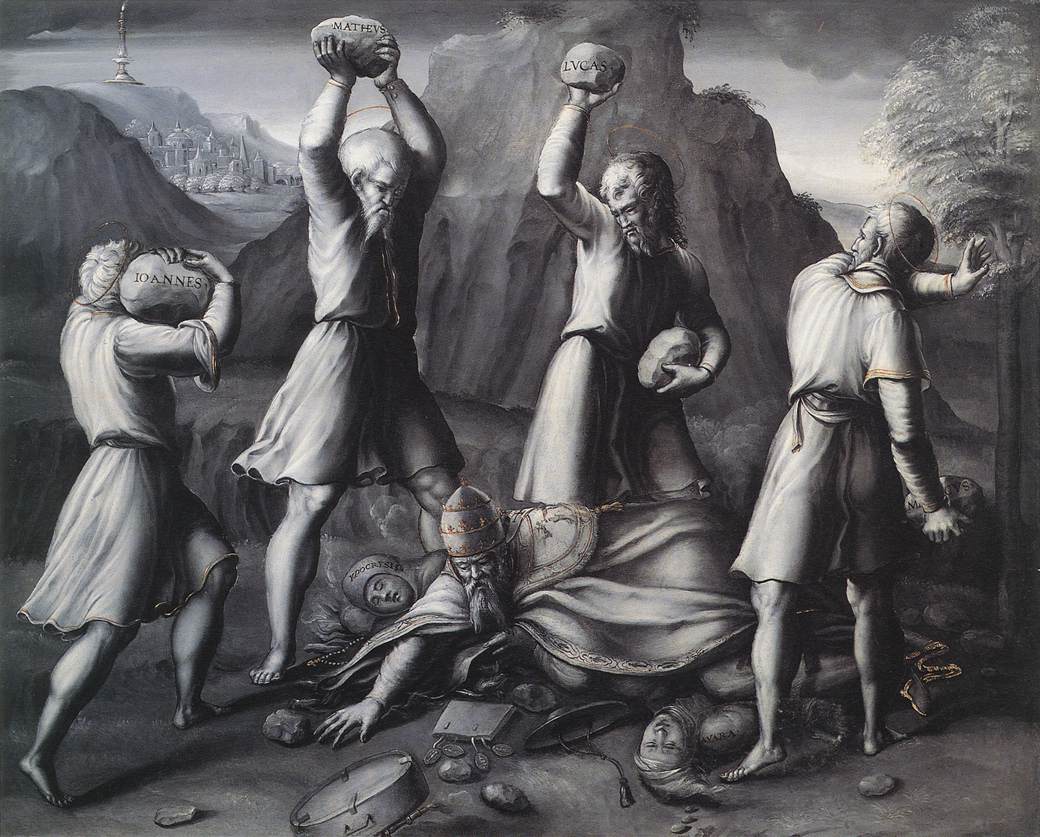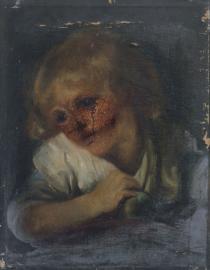The religious rooms came first (understandably as this is what you first thing of when you think of iconoclasm) and they gave a good insight into the reasons behind the English Iconoclasm (the reformation, Henry VIII and Edward VI) and had an large number of examples ranging from smashed stain glass windows to scratched out faces of saints in panel paintings. The really striking image you see by Girolamo de Treviso, 'A Protestant Allegory', upon entering the room, where four protestants are smashing rocks down on the pope who is using his body to protect holy items such as texts and relics, is particularly poignant in describing the generalised attitude of the British public, and the artifacts surrounding the picture of physical proof of this.
Despite the religious element in the exhibition being the biggest, this isn't what engaged me the most - the middle area of politics was, to me, the most interesting, showing the destruction of pillars, statues and commemorative architecture of certain leaders in large scale black and white photographs, alongside a remaining and damaged part of the statue and an explanatory wall writing of who the statue was of and his influence within Britain. This part of the exhibition was incredibly informative, in particular the huge photo of Nelsons Pillar in Dublin in 1966 after it had been attacked by the IRA, showing the whole bottom of the pillar covered in rubble. Having news reports playing next to clearly showed the impact it had, giving the original photo more depth and understanding.
Surprisingly, I particularly enjoyed the Suffragettes too. It's really interesting that art was used as a way of political uprising - the attack on art clearly showed how much people invested in art works, as attacking it if no one cared about it would have been a waste of time. I found it really interesting how violent these women would be too - one of the earliest attacks was in 1913, and these continued reoccurring until 1914, with violent attacks by people such as Mary Richardson on the Rokeby Venus at the National Gallery (resulting the a two week closure, followed by them closing for 3 months after another attack). Women were becoming suspects in the art world - they were asked to leave their things at the door to avoid attacks - some of them were with meat cleavers.
There was a particularly funny piece in this room too from Blast, a small magazine, in 1914 which spoke directly to the Suffragettes. You don't mind being called things?
Art is a powerful way to get your message across. Whether it's through destroying art to cause outrage or by making the art to be particularly potent itself, art is a great way to ensue political ideologies.
Art being powerful is also a main point of the last room in the exhibition - Aesthetics. This is a room of art that has been created through a means of destruction, my favourite piece being by the Chapman brothers with their ongoing series 'One day you will no longer be loved', where they purchase old paintings and then paint over them, showing the portraits in them to be decaying, old bodies, and explaining both the reason and the title by saying that they subjects aren't loved anymore because their portrait was sold on and discarded and reworked. These paintings for me are incredibly eerie, and knowing that they are original portraits that have been painted over made me feel a bit weird, clearly because it's ingrained in me that once a work of art is completed it should probably never be touched again.




No comments:
Post a Comment